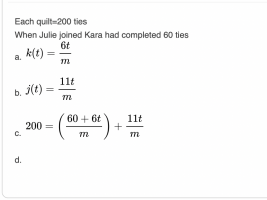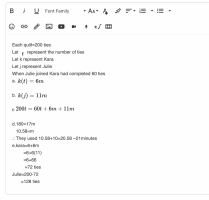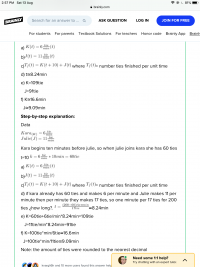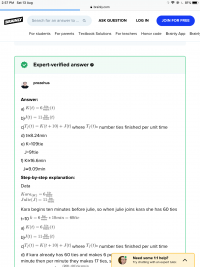Kara starts tying a baby quilt at the local community center. Each quilt takes 200 ties to complete. Ten minutes later Julie joins Kara, and both stay to finish the quilt. Kara ties 6 per minute and Julie can tie 11 per minute.
a. Write an expression to show the number of ties Kara has completed after m minutes.
b. Using the same variable m, write an expression for the number of ties Julie has completed.
c. If you know they finished the quilt, write an equation to model the situation.
d. How many minutes did it take them to finish the quilt?
e. How many did each of them tie?
f. Suppose they tied the same amount. How long would it take?
g. How many did each of them tie?
h. The next week, Julie couldn’t make it so her friend Susan came to help. Susan can tie the ties ¾ as fast as Kara. Using the same variable m, write an expression for the number of ties Susan has completed.
1h. If you know they finished a quilt, write an equation to model the situation.
2h. How many minutes did it take them to finish the quilt?
3h. How many did each of them tie?
solution;

This is what I have so far. I am stuck because I don't know if I should subtract the 60 ties Kara did before writing my equation.
a. Write an expression to show the number of ties Kara has completed after m minutes.
b. Using the same variable m, write an expression for the number of ties Julie has completed.
c. If you know they finished the quilt, write an equation to model the situation.
d. How many minutes did it take them to finish the quilt?
e. How many did each of them tie?
f. Suppose they tied the same amount. How long would it take?
g. How many did each of them tie?
h. The next week, Julie couldn’t make it so her friend Susan came to help. Susan can tie the ties ¾ as fast as Kara. Using the same variable m, write an expression for the number of ties Susan has completed.
1h. If you know they finished a quilt, write an equation to model the situation.
2h. How many minutes did it take them to finish the quilt?
3h. How many did each of them tie?
solution;

This is what I have so far. I am stuck because I don't know if I should subtract the 60 ties Kara did before writing my equation.




